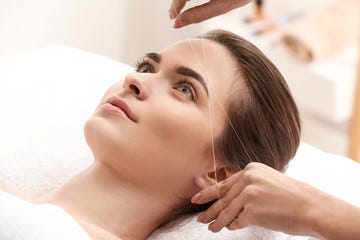Does Waxing Upper Lip Cause Hair to Grow Back Thicker?

Upper lip hair is a major concern among ladies. The thought of having a lady mustache can cause some appearance – if not self-esteem issues – in most people. Fortunately, hair removal methods such as waxing have been developed to address this problem.
While they are effective and not THAT painful, some ladies are hesitant to try this option because of the hair growth myths surrounding it. Thankfully this article delivers the facts, including the answer to the age-old question, “Does waxing upper lip cause hair to grow back thicker?”
But First, What is Waxing?
Waxing is the process of removing hair strands by pulling them out of their roots. For most people, it is a little bit painful because hair strands are strongly attached to the said areas. But for some – especially those are waxed often – the process only produces a tolerable tugging motion.
No matter what your pain perception might be, the upside to waxing is that it provides clean hair removal, meaning no stray hairs are left here and there. And, in the unlikely event that some locks are left, they can be easily removed with a pair of tweezers.
Also read: Does Waxing Make Hair Thinner?
Does Waxing Upper Lip Cause Hair to Grow Back Thicker?
NO. Contrary to popular beliefs, hair doesn’t grow thicker after waxing.
According to experts, since the hair is ripped from the root, waxing damages it – in a good way. A damaged hair bulb means that should hair grow back, it’s usually finer and less sparse.
Hot Waxing
Two types of wax can be used for your upper lip. The first is hot wax. Under this are two more categories. Your therapist might make use of soft wax, or he/she might use hot wax. After any of these are applied, a strip will be placed on top of it. Once the wax sticks, the strip is swiftly removed (against the grain of the hair) resulting in clean hair removal.
What’s great about hot waxing is the precision that comes with it. The therapist has full control of the material, ergo she can shape it accordingly for full hair removal. It’s also best for shorter, finer hairs, which is usually the case for the upper lip.
The risk here is the potential of getting burned – especially if you are an inexperienced waxer – or if you decide to go to one. Of course, you can easily prevent this by having this done at a reputable salon.
Cold Waxing
Another type used for the upper lip is cold wax. Contrary to its name, it comes with a lukewarm temperature. The strip is rubbed after its application. It is then removed quickly, as is the case with hot wax.
A benefit to using cold wax is that you can do it on your own – although you can have a therapist do it as well. Most cold wax strips are handy, meaning you can take it wherever you wish to go. This is especially useful if you wish to be hair-free in the midst of a long vacation.
However, cold wax strips need to be re-applied to get the same degree of hair removal as with hot wax. Of course, the repeated application means that you have to endure some discomfort again – and again – and again.
Before Waxing
Should you decide to get waxed, you need to prep your upper lip area with a pH-balanced cleanser. This can help unclog the hair roots of dirt and debris.
You can also use a chemical exfoliant, such as glycolic acid, which can kill bacteria and remove oil (sebum) as well. More importantly, this product can help prevent skin discoloration and the proliferation of ingrown hair. This product can be used post-waxing as well.
If you are using creams that contain retinoids, you need to tell your therapist right away. This chemical brings about increased exfoliation. If coupled with waxing (an activity that exfoliates the skin as well), there’s a chance that your skin might get burned or peeled off.
After Waxing
Keep in mind that your upper lip might turn red and irritated after a bout of waxing. This is not permanent though. At the very most the said symptoms can last a day, if not lesser.
To prevent it from getting irritated even further, avoid scratching the area. Yes, it might be hard, but don’t you dare touch it!
Other after-care tips include the application of post-wax lotion, which is usually offered in most waxing salons. You should also try to avoid sun exposure and hot baths for at least 24 hours.
Additionally, it would help if apply an anti-bacterial ointment to the waxed area. Remember that the pores are wide open after waxing, and such they are highly susceptible to infection.
Waxing is a terrifying thought for many because of the pain and redness that usually come with it. Although this is the case, it is highly effective! So before you think twice and ask yourself “Does waxing upper lip cause hair to grow back faster?” Know that the answer is NO. If you want to be hair-free for weeks on end, then waxing is the best option for your lady ‘stache.